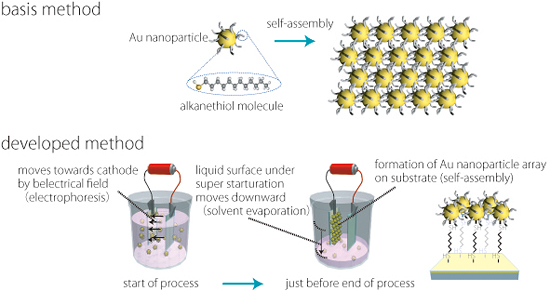Dense Array of Nanometer-Scale Light Sources on Large-Area Substrate
Toward Application to High Efficiency Sensors
2010.11.22
National Institute for Materials Science
A team headed by Dr. Kazushi Miki, Group Leader of the Nano Architecture Group, NIMS, succeed in realizing a large-area near-field light source by arraying trillion of point light "near-field light" sources on a substrate with a size of 1cm2. Use in various technologies is expected.
Abstract
- A team headed by Dr. Kazushi Miki, Group Leader of the Nano Architecture Group of the Organic Nanomaterials Center (Managing Director: Izumi Ichinose), National Institute for Materials Science (President: Sukekatsu Ushioda) succeed in realizing a large-area near-field light source by arraying trillion of point light “near-field light” sources on a substrate with a size of 1cm2. Use in various technologies is expected.
- Near-field light is a nanotechnology which enables resolution exceeding the diffraction limit and is the principle of the near-field optical microscope, which provides resolution on the order of 50nm. Due to a focus on ultra-high resolution and ultra-miniaturization in measurement technologies and manufacturing technologies, nanoscale point light sources had been the main stream in near-field light technologies. As another aspect of near-field light, because it is possible to collect light, application to optical sensors, photovoltaic cells, and similar fields has been expected in recent years. However, due to inefficient optical power of one point light source, practical large-area plane light sources with sizes of cm2 to m2, which are typical sizes of devices in these fields, are necessary to realize these devices. How to realize large-area light sources with nanoscale near-field point light sources, which are generated at a sharp metal tip or the microscopic aperture at the end of a fiber probe, was an issue.
- In the present work, the NIMS research group focused on the aggregation phenomenon of colloidal AuNPs coated with alkanethiol molecules which form arrays by self-assembly. Based on this technique, the researchers developed a combination of two additional techniques which makes it possible to achieve a dense array of Au nanoparticles with equal interparticle spacing. The basis of this method is the basic technique of formation of arrays by self-assembly. By modifying commercial Au nanoparticles with alkanethiol molecules, it is possible to form an array in which the Au nanoparticles are arranged with an equal spacing between the nanoparticles. Secondly, the Au nanoparticles can be induced onto a conductive substrate by the electrophoresis method. Thirdly, formation of an array of Au nanoparticles on the conductive substrate can be promoted by the solvent evaporation method. Furthermore, a mechanically-strong structure can be realized by chemical bonding between the conductive substrate and the Au nanoparticles by also modifying the conductive substrate with alkanethiol molecules. It was confirmed that the wavelength of the near-field light source (600–1100 nm) can be coarse-adjusted by changing the size of the AuNPs (10–50 nm) and fine-adjusted by changing the spacing of the array (1.5–3.0 nm). This light sources is a large-area light source in which near-field light is generated over the entire surface of the Au nanoparticle array by forming an array of the near-field light sources generated at the Au nanoparticles.
- This achievement is a basic technology for practical application of near-field light to devices, etc. By making it possible to create near-field light sources with large areas, this breakthrough technology will enable application of near-field light to a wide range of fields, including the development of high-efficiency solar cell technology, high-sensitivity chemical sensors, and high-sensitivity biological sensors.
- This research was carried out as a part of invitational research “Direct Demonstration of Strong Photon-Molecule Coupling Chemical Reaction Using Fluid Device” (H21-H23) (Research Representative: Kazushi Miki) in the Ministry of Education, Culture, Sports, Science and Technology (MEXT) Grants-in-Aid for Scientific Research on Priority Areas, “Creation of Strong Photon-Molecule Coupling Reaction Fields” (Area Representative: Professor Hiroaki Misawa, Hokkaido University, http://photomolecule.net/). These results was published in Applied Physics Letters.

Fig. 2 Schematic illustration of method arraying AuNPs (Top) Base technology, self-assembly on substrate (Bottom) New techniques developed based on basic technique
